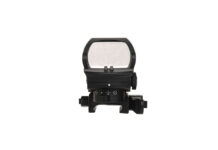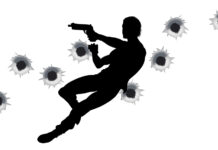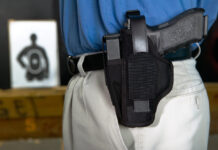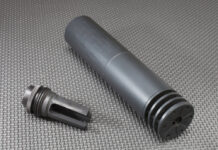Survivalists and preppers spend a lot of time worrying about how they’ll protect themselves after SHTF. And rightfully so, the landscape after a major crisis is going to be extremely dangerous, and preparedness is the only way to make sure you stay safe.
However, it’s important not to get complacent when conditions are good too. Even if everything is as it should be, there are still dangerous threats that lurk in the shadows of our day-to-day lives.
Home intrusion is one of those threats.
How should you respond in the event of a home intrusion? When you come face-to-face with an intruder, the way you react could mean the difference between life and death for your family.
Thankfully, Grady Powell at My Family Survival Plan has some sage wisdom on the topic:
1. Plan it, drill it. Everyone remembers the fire drills that were practiced in elementary school. The alarm bell sounded and a swarm of generally chaotic creatures with an inclination for ignoring direction suddenly fell into line and moved to a predetermined point of safety with precise exaction. In the same vein, create a simple plan to move everyone living in your house to a pre-determined point of safety, which ideally will be room with few exit points. Only leave the security of the room you are in if other loved ones need to be secured. Everyone should know what starts the plan . . .
An alarm, a whistle, or predetermined action initiating word. Adults should plan to move to children or the elderly. Older children should move to younger ones and they should all move to a predetermined meeting point or hiding place in the room, and stay put. Panicked people tend to wander if they don’t have a highly defined place. Designating these locations will give you the ability to discriminate targets far more quickly and effectively if an assailant has made it into the kids’ rooms.
Using techniques similar to those the police employ to deal with active shooters is best for the solo shooter: Don’t clear every room or move tepidly through the house. Instead, move quickly and decisively to the objective point and only engage bad guys that are an immediate threat or in the way. Understand the layout of your house and identify likely entry points/weak points. Set up a primary route and secondary route if available to get to your objective and plot out areas an invader will be likely to move through or toward. Move to the hold point and wait it out. Remain silent and listen. After sufficient time has passed, then go through the home. If anything indicates that an intruder is present, call the police and let them clear the house in a team. Better to look a little sheepish than go on a one-man house clearing suicide mission leaving your family members unprotected.
When you call the police, tell them precisely where you and your family are located in the house. Tell them that you are armed, have received firearms training and that all your family members are safe and secure with you. Ask them to carefully and loudly identify themselves when entering your strongpoint. Once the plan is set, drill it multiple times. Practice. Practice. Practice. Your wife may think you’re a tin-foil-hat-wearing wack-o and the kids will think it is cool. Run through it several times, both during the day, then again at night with low light/no light. Then have an occasional surprise drill. If and when the real thing happens, you’ll be surprised to see how a standard operating procedure keeps a stressful situation a lot calmer and more coordinated.
2. Have an early warning. Police response to home alarms are notoriously slow and often set as a priority right above extracting cats from trees. Forget or even disconnect that part of it, but have a good alarm system installed set to activate instantly when a door or window is breached and use it religiously so you’ll be acutely aware of the moment someone enters your perimeter. You have the luxury of knowing who belongs inside those walls and who doesn’t. Once your alarm system is in place, the moment you hear it go off, it’s time to execute your plan. Make sure to disengage the alarm quickly so your hearing can be used to detect interior movement.
3. Prepare resources. Make sure firearms, flashlights and telephones are readily available. Waking up to an alarm, still foggy from sleep, is not the time to be fumbling with combination locks on a gun safe or scratching through your drawer looking for a light. Install quick-access gun safes next to your bed and make sure a phone and flashlight are on the night stand. Practice using them.
An good alternative is a vehicle-style shotgun lock like those used by police. These can be attached to bed frames and hidden by dust covers but accessed with a hidden switch. Computer cash drawers can be purchased on eBay for peanuts and with rudimentary knowledge of electronics, wired complete with battery backup and hidden activation switch. Stash an old cell phone and charging cord in the stronghold room. Even deactivated phones can still call 911. Also, store critical first-aid supplies, such as a CAT tourniquet, quick clot agent and any prescription medicines necessary for household members. If for some reason you take a hit on the way to your secure point you’ll be able to buy yourself time.
Add a few bottles of water for a short potential wait. Enter the direct dispatch number for the local law enforcement on your phone and print detailed directions to your house and to the stronghold inside the house and tuck them away in your safe room. Direct dispatch will almost always function faster than 911. For the ultra-prepared, a great innocuous cover barricade can be made by putting a full set of bookshelves, tightly packed with books, in a strategic place in your stronghold room.
4. Harden the structure. A man’s home is his castle and one of the best defenses is making your castle a more difficult target than your neighbors’. Encourage the assailant to choose the path of least resistance and go down the street. Remove shrubs and plants close to the house that make good hiding points. Better yet, replace them with thorny bushes that will discourage anyone from trying to move through them. Consider glass bricks as a relatively cheap and bombproof replacement for exterior windows in first floor bedrooms. Use quality locks and, even more important, install door jambs that will resist kicking and crowbars.
As a super economical alternative, drill 1-inch holes in the floor at the foot of both sides of the door and place pieces of steel pipe in them to secure the door at night. While not exactly esthetic pleasing, the pipes can be easily removed and the holes covered by an entry mat. Make sure that entry and exits points are well lit and windows are covered to prevent people from getting a look at the valuables in your house. And get a dog- even the small ones bark when they sense an unwanted presence near or in the house.
5. Get Adequate and Applicable Training. Don’t let the first time you shoot your gun in the dark with a light be when a bad guy has just broken in. The fewer first time variables you experience in a real fight, the better off you will be. Numerous schools exist that provide valuable instruction and practice in night shooting, civilian room combat and scenario-based gunfighting skills. Often this instruction is provided by individuals with substantial combat experience. Many, including Asymmetric Solutions, use full-size ballistic house mock ups that allow the shooter to simulate tactical movement through the structure while engaging strategically placed targets.
Also consider taking an intensive first aid course that will help you deal with a serious medical issue while waiting for the police to arrive and clear your house. Wilderness first aid classes designed to teach civilians how to care for major medical problems when help is at a distance are far more intensive and full of practical knowledge than the basic “call 911 and apply direct pressure” quickie basic first aid/CPR courses. Asymmetric Solutions would, of course, like to be a part of your training and offers a wide spectrum of reality-based training courses to civilians. If you don’t use us, find a solid firearms school and make sure you’re prepared. We can vouch for CSAT, TFTT, Gunsite and EAG Tactical from personal experience, but there are plenty of other good ones out there. Bottom line: making holes in paper down a shooting range lane will not – in any way – prepare you for the real fight. Reality-based training will.
These steps will be met by some with the thought that, “Home invasions are rare and would never happen to me.” That, of course, is usually correct. Insurance companies are highly profitable institutions that bet on bad things not happening. Still, nearly all of us spend thousands yearly with insurance companies to prepare ourselves for those rare contingencies.
We will also hear the classic “That level of preparation is paranoid.” One man’s paranoia is another man preparation until the preparation is needed. At that point paranoia is reclassified as insight. I’m not paranoid when I drive my car because I wear my seatbelt any more than my grade school principal was paranoid when he made us do fire drills. Being prepared gives you options and puts you in greater control of your situation. While home invasions are relatively unlikely, consider the value of the people and things inside your four walls. Personally, I will never let a few dollars spent on training and equipment, a little inconvenience and time spent in planning and practice and the imposition of a plan for my family be too great a cost to increase the surety of their safety and well-being.
Do you agree with these tactics? What other practices do you have for making sure you and your family are prepared to handle an intruder?
Explain in the comments.







![Are Compensators Worth It? [Video]](https://preparedgunowners.com/wp-content/uploads/2025/07/Depositphotos_815431992_S-218x150.jpg)























![Optic Ready vs Milled slides? [Video]](https://preparedgunowners.com/wp-content/uploads/2024/02/image-3-100x70.png)
![[Checklist] What Gear You Need To Take Pistol, Rifle & Shotgun Training Courses [Video]](https://preparedgunowners.com/wp-content/uploads/2023/07/Depositphotos_275087632_L-100x70.jpg)
![What is in Carter’s 2023 EDC? [Video]](https://preparedgunowners.com/wp-content/uploads/2023/07/Depositphotos_146856137_L-100x70.jpg)



One thing that I have done is replaced all the glass in the outer doors with lexsean. I have CVTV cameras that can be watch from cell phone or the bedroom. A person needs to let the pos come to them if they are in a 2 story or at the end of a hallway. You need to use lay out for your best.
The point about the M-16 is a little off. I was a Navy Gunner’s Mate serving in the Mobile Riverine Force in the Delta at the time the M-16 was being phased in. As originally designed, the bolt had no mechanism for “forcing it home” if some debris was in the chamber holding up chambering the round. All you had was the charging handle with which you pulled the bolt back, while the recoil spring was supposed to push the bolt home and chamber a round when the charging handle was released. Obviously if anything slowed down the round being chambered it jammed. They solved that problem with the serrations on the side of the bolt and the angled spring-loaded plunger to work the bolt home in this situation. That took care of most of the problems I ever heard of. I never heard anything about it “cleaning itself…”
If at all possible have a dog, although mentioned this cannot be over-stressed. A dog will not only sound an alarm, but the sound of its barking will tend to back off an intruder.
all good stuff and real life FACTS but modfing stuff in apartments is not easy to do or cheap
The use of a firearm should be the last resort. We need to be proficient in the use of firearms and know when the situation dictates deadly force is the only viable resolution.
If you must shoot an intruder: SHOOT TO KILL, Dead thugs don’t sue.
In the confines of an apartment or house; I prefer a shot gun with #4 shot. Reason being: there are lots of pellets that probably won’t “shoot thru” walls and maim or kill innocent people on the other side of the wall. A 20 gauge is ideal due to lower recoil, especially for the older or small frame, the ammo is cheaper and more plentiful. A 12 gauge with 00buck smacks of too much testosterone and little brain power.
Most intruders are shot at very short distances, less than 30 feet. At such a short range: that #4 shot will transfer enough torque to knock a grown man off his feet. The shot pattern will spread some but; still be fairly tight, so even a near miss will probably still hit the target.
A 9mm Glock with frangible hollow points, like the sky marshals carry in airplanes wont shoot thru sheet rock walls, should be on your side, in case the intruder gets up. It takes more than one hit to totally incapacitate a drugged up intruder, unless it was a head shot. Head shots are rare in a stressful situation. Center of mass is the best alternative. Always “double tap”.
Mount a tactical light with a strobe function and practice, practice, practice, The strobe will be very disorienting at first; you will get used to it. The object is to cause the intruder to become disoriented. If the intruder is near the point of entry: he/she may turn and run.
Just the sound of the slide of a shotgun being “racked” is most likely enough to make even the most dimwitted thug turn and run.
Personally knowing of one person being killed by an intruder and another victim terrified by an intruder who robbed her was more than enough to realize it don’t always happen to “somebody else”.
Situational awareness is key, and knowing what to do in any unwanted situation. Automatic out door lighting sometimes makes a thug look for easier pickings.
Leave a radio talk show running at a low volume. The sound of indistinguishable voices makes it seem as though someone is awake and aware. Thugs are cowards, They like to sneak up and knock you on the back of the head or murder you in bed.
A baby monitor with the receiver in a part of the house that would be opposite your planned location would be a handy diversion when you hold the transmitter close to your mouth and make a noise; would make the intruder turn his back to you making him/her a very tempting non-threatening target! It would be more preferred to make the thug turn around again and be off balance where I would recommend shooting the thug then. Don’t shoot the thug in the back!
Use the distraction to throw them off balance and less likely to take aim if they are armed. If it turns out the thug is not armed; you should have planned ahead and purchased a realistic toy gun, that can not be traced back to you, so the intruder appeared to be armed when you shot him/her. Make sure their fingerprints are all over the weapon, not yours or your DNA. You were wearing rubber gloves, the thin cheap kind that will flush down the toilet? This should be part of your practice sessions, in case you have to CYA!
CCTV with infrared capability for home surveillance is inexpensive and is also good as a “nanny cam” if you have children and use the services of a baby sitter. most of the systems have an optional USB port you can plug another HDD into. A burglar who strikes while you are away will rip the box out so any recording goes with him/her. That HDD you plugged into the USB port should be well hidden so you still have a recording for LE should you suffer a break-in.
There’s a lot of psychology to be used in defending your life and property. The outside lights, the radio, the baby monitor, an alarm, the sound of a racking shot gun, the strobe light. If they insist on coming in anyway: THEY ARE THERE TO KILL YOU! When you take them out: make sure they are in the house and they are armed, or appear to be.
Kim: out.
Comments are closed.